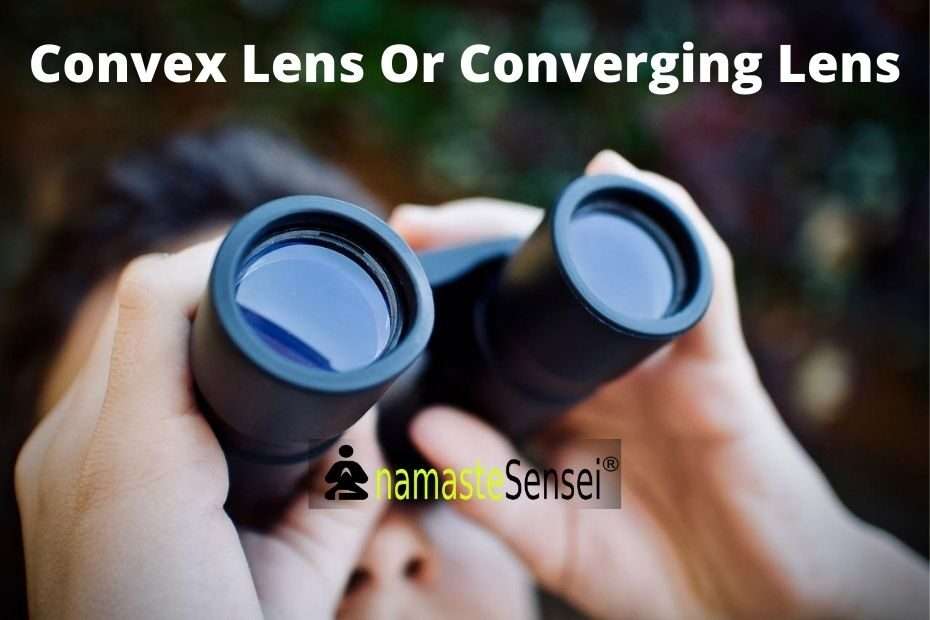Advertisements
-
Convex lens Or converging lens

What is Convex Lens?
- The term convex arises from the fact that one or both faces of the glass bulge outward at the center.
- A convex lens is sometimes called a converging lens.
- It brings parallel light rays to a sharp focus or focal point, as shown (Fig A), when those rays are parallel to the axis of the lens.
- It also can collimate (make parallel) the light from a point source, as shown in (Fig. B).
- The properties of a convex lens depend on the diameter and the difference in thickness between the edges and the center. The larger the diameter, the greater the light-gathering power. The greater the difference in thickness between the center and the edges, the shorter the distance between the lens and the point at which it brings parallel light rays to a focus.
- Light Gathering Area
The effective area of the lens, measured in a plane perpendicular to the axis, is known as the light-gathering area. - Focal Length
The distance between the center of the lens and the focal point (as shown in Fig A or Fig B) is called the focal length. - If you look through a converging lens at a close-up object such as a coin, the features are magnified; they appear larger than they look with the unaided eye.
- The light rays from an object at a great distance from a convex lens converge to form a real image at the focal point.
-
Convex Lens Diagram | Converging Lens Diagram
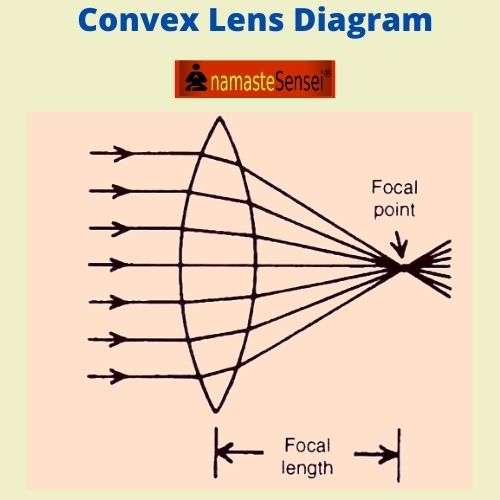
- The figure in this frame shows a great number of rays passing through a lens. After they pass through, they come together or converge.
- Lenses such as this thicker at the center than at the edges are called converging lenses.
- They are three-dimensional, appearing somewhat like that shape obtained by inverting one dinner plate on top of another. If the lens is made correctly (as is the one shown), the rays converge so that they cross at a single point.
- In the above figure, the rays are parallel to one another and to the axis of the lens as they enter at the left.
The point at which parallel rays converge after passing through a lens is called the focal point of the lens. - Focal Length Of Convex Lens – The distance from the lens to the focal point is called the focal length of the lens.
To read more about Focal Length of the convex Lens, you can read this linked Article.
Recommended Read: Focal Length of Convex Lens
-
Types of Convex lens
- Plano-Convex Lens
- Double Convex Lens
-
Plano-Convex Lens
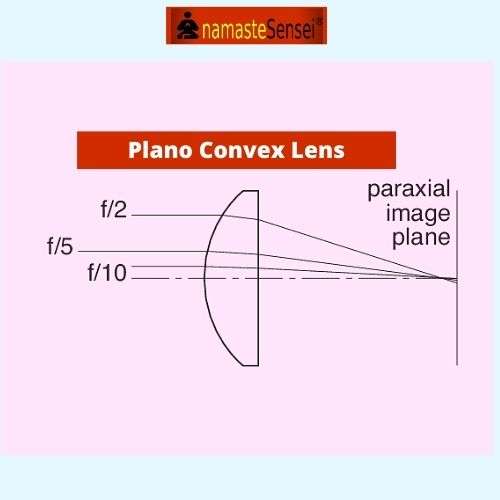
- Plano-Convex lenses are the best choice for focusing parallel rays of light to a single point. It is curved outwards from one side and the other side. It has positive focal length elements that have one spherical surface and one flat surface.
- These lenses are designed for infinite parallel light use in non-critical applications. These optical lenses are for all-purpose focusing elements. It is used in pharmaceuticals, defense, robots, etc.
-
Double Convex Lens
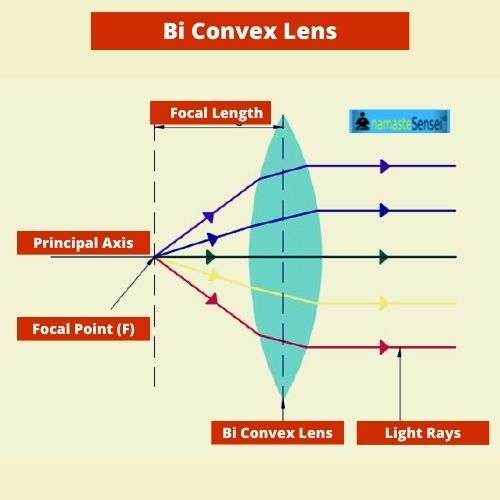
- Biconvex lenses also known as double convex lenses are simple optical lenses with two convex spherical surfaces, surfaces that bulge out from the center.
These two convex surfaces have the same radius of curvature, and the lens focuses parallel rays of light to a single point beyond the lens. - Double convex lenses play an important part in many imaging devices such as microscopes, cameras, telescopes, and image relays. They are used to focus and control laser beams and in telecom IR applications.
- They have a shorter focal length than Plano-convex lenses of equal diameter and surface radius. So many optical devices require longer focal lengths. Hence, double convex lenses are preferred. It produced the virtual image for the human eye and the real image for photography, an optical sensor, and is also used in burning glass.
-
Convex or converging Lens Uses
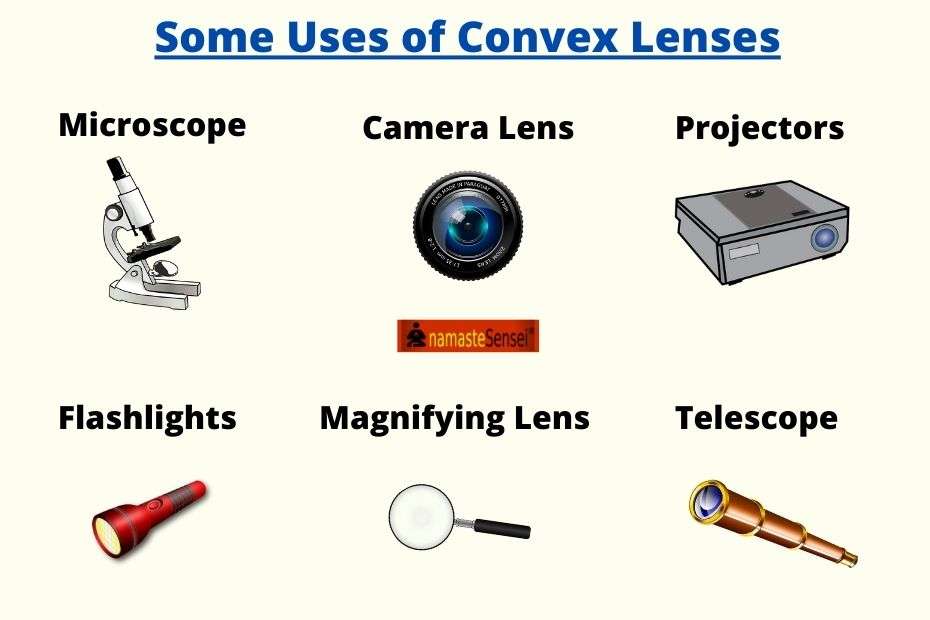
Advertisements
Some of the usage of convex lenses are given below.
- Microscope
- Magnifying glasses
- Optical lens in the camera
- Projectors
- Telescope
-
MICROSCOPE
- Microscopes use convex lenses in order to focus light. For the purposes of microscopy, convex lenses are used for their ability to focus light at a single point.
- This is how the human eye works, with the convex biological lens focusing light on the back of your eye where rod and cone cells can detect it.
-
MAGNIFYING GLASS
- A magnifying glass is a convex lens used to make an object seem much bigger than it is. This works when the object is placed at a distance less than the focal length from the lens. A magnifying glass uses a convex lens because these lenses cause light rays to converge, or come together.
- As the light rays enter the convex lens present in the magnifying glass, these rays become focused on a specific focal point in front of the center of the lens.
Furthermore, if the magnifying glass is at an optimal distance, this generates the utmost magnification of the object.
-
Optical Lens in the camera
- Convex lenses are used for optical lenses in cameras as a primary lenses.
-
A camera consists of three main parts.
a. The body is light-tight and contains all the mechanical parts.
b. The lens is a convex (converging) lens.
c. The film or a charged couple device in the case of a digital camera.
-
Projectors
- Projectors are used to display large pictures by projecting it onto a screen.
- A convex lens is used in projectors to get a magnified image.
-
Telescope
- Telescope has both convex and concave lenses.
- The telescope must have one convex lens as one of the two lenses since the convex lens is used to magnify the objects by bending the path of light.
- The concave lens is used to extend the focal length in some telescope designs.
-
Some definitions Related to Lenses
- Optical Center
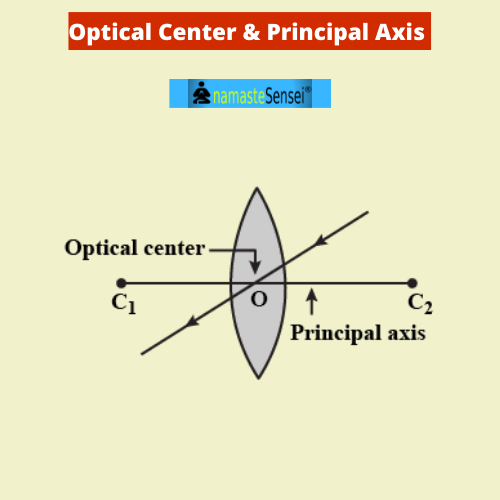
- The center point of a lens is known as its optical center. It is represented by O. The optical center is a point of the lens, directed to which incident rays refract without any deviation in the path.
- Centres of Curvature
- The centres of the two imaginary spheres of which the lens is a part are called centres of curvature of the lens. It is represented by C. A lens has two centres of curvature with respect to its two curved surfaces.
- Radii of Curvature
- The radii of two imaginary spheres of which the lens is a part is called radii of curvature of the lens. A lens has two radii of curvature. They may or may not be equal.
- Principal Axis

- The imaginary line joining the two centers of curvature is called the principal axis of a lens. The principal axis also passes through the optical center.
- Focal Length of lens
- The distance between the focus and optical center of the lens is called the focal length of the lens.
- Focal Plane
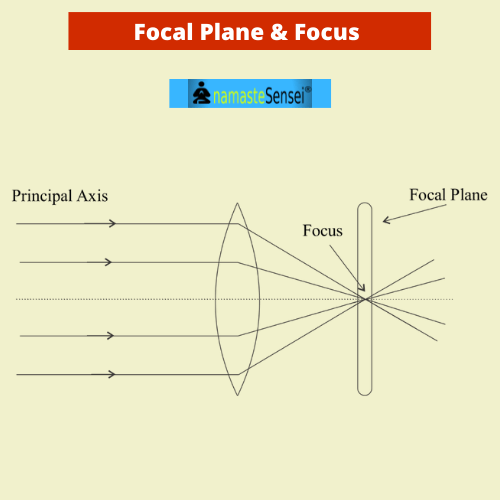
- The plane passing through the focus and perpendicular to the principal axis is called the focal plane.
- Aperture
- The effective diameter of the circular outline of a spherical lens is called its aperture.
Congratulations, you have read the complete article about what is a convex lens? If you have any doubts or queries, feel free to comment below. We will respond as soon as possible.
Or Email Us At [email protected]
More Articles:
| 30 Examples Of Vector Quantity | Difference Between Scalar And Vector Quantity |
Any topic you want us to cover? Let us know.
Advertisements
